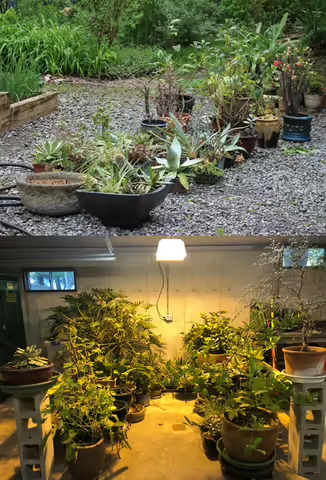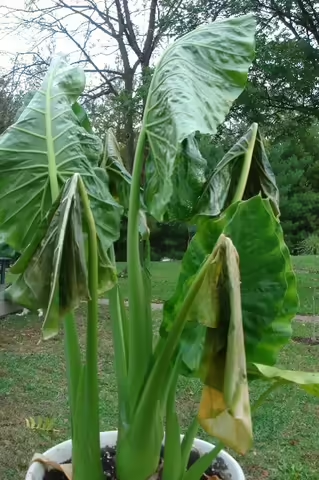Hard to believe but the median date for the first frost is just around the corner, and I still have lots to do in the garden. Last year the first freeze occurred on October 5, so I know it can happen any time now.
Number one on my mind is the overwintering of tender plants I plan to protect and keep. Most are in containers, so I have started gathering them all to a central point where I can prep them before their final move into the garage. For prep, I inspect each container thoroughly for any stowaway tree frogs and toads, in addition to trimming back and removing all dead plant debris and weeds. Once frogs, toads and undesirable plant material is removed, I treat the plants with insecticidal soap to manage any remaining mites, aphids or scale. Once dry, my final step is to wipe down the outside of each pot and match it to a drain tray.
My garage is unheated, but at the same time it never freezes since all but the overhead door is surrounded by ground or house…just about perfect for overwintering plants temperature-wise. I have one high intensity discharge lamp (400 watt sodium) that I hang about 5 feet above the plants and run on a timer for 14 hours a day. Using floral picks, I also scatter a few sticky traps amongst the containers to manage white flies and gnats. On nice days, I can just run the hose into the garage to water when needed. Otherwise, a watering can does the job too.
The colder it gets, the less often I have to water, and vice versa. When I get the winter blues, it’s also a nice space to just stand and breathe in plants.
I usually wait until the first hard frost knocks back the foliage before digging dahlias, tuberose (Agave amica), elephant ears (Colocasia sp.), cannas and the like. After removing the old stalk, I store the remaining storage structures in trays of slightly moistened peat moss in a dark, cool (non-freezing) location. I insert the trays in black garage bags to help keep them dark despite lights coming on and off.
I do quite a bit of garden cleanup in the fall, but more in the form of weeding. For me, going into winter clear of weeds as much as possible gives me more breathing room the following spring. I tend to mulch an area after weeding to suppress weeds that require light to germinate, especially my arch nemesis hairy crabweed (Fatoua villosa). Though not a consideration for those following organic principles, another option would be to apply a germination inhibiting herbicide like trifluralin directly after weeding, which should supply up to six weeks of control. Trifluralin is one of the active ingredients in the Preen product line as well as a common ingredient in weed and feed turf products.
Don’t get me wrong, fall is about planting too. In addition to planting flower bulbs and garlic, I have a number of perennials in containers that need to be replanted in the garden before freezing temperatures become the norm. Plus, who can resist fall plant sales!

